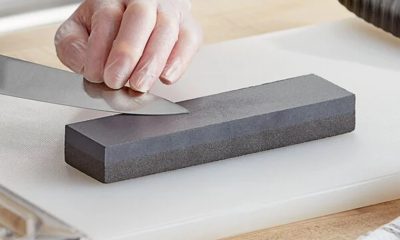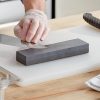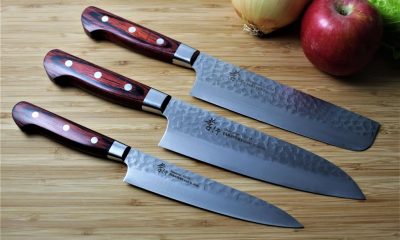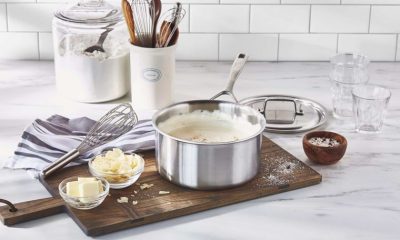Kitchenware
The Complete Guide to Kitchen Knives: Make Meal Prep an Ease
Of all the things chef, one thing is clear: if you want to be a good cook, you need a good knife. And you want to care for your knives – learn to sharpen, hone, clean and store them safely. Whether for chopping, mincing, slicing or dicing, a suitable knife is the workhorse of all kitchen utensils, making meal prep a breeze. Here’s everything you need to know about kitchen knives.
What Are the 3 Knives Every Person Should Own?

When you start your knife-shopping journey, you’ll notice many types available, along with the sharpening, honing and storing tools for them. If you’re only starting your blade collection, then it’s best to buy knives of quality and type you’ll use the most.
Sometimes that means buying only one or a maximum of two knives of premium quality that fit your hand perfectly and are easy to use. If you need a different blade in your kitchen, you can get a separate, more purpose-specific kitchen knife later and design your collection of knives. Here are the three most favoured knives that any cook finds helpful.
The Chef’s Knife
A chef’s knife would be your best option if you decide to buy one knife. You can use it for almost any purpose, and it’s large and sturdy enough to handle heavier foods that may require extra force to chop effectively. A chef’s knife helps cut and mince vegetables and herbs, slice meats, break down fish and poultry, and do almost any kitchen-related task.
The chef’s knife is by far the most versatile, and its name reflects this. These knives typically have a 12-26 cm blade, with longer knives being more balanced. Finally, you should choose a size based on what feels most comfortable. Gyuto is the equivalent of a chef’s knife if you go for a Japanese knife.
The Paring Knife
The paring knife, or a utility knife, is comparable to a chef’s knife. While a chef’s knife can be used for precision work, smaller knives with blades ranging from 5 to 10 cm are good for cutting and mincing smaller vegetables and herbs. Paring knives are also useful for trimming larger pieces of meat with less waste.
The Serrated Knife
Serrated blades, while less versatile than a chef’s knife or a paring knife, are essential kitchen tools. Straight and curved-edge knives are excellent for chopping and slicing harder materials but can easily shatter softer things such as bread loaves or tomatoes. The serrated edge helps you to cut back and forth effortlessly without placing direct pressure on the food. A chef’s knife may be more versatile, but the serrated blade is more replaceable because it’s tough to sharpen at home. As a result, choosing the cheaper option is a good idea in this circumstance.
When and Why Buy a Knife Set?

While it may appear convenient, buying a whole set of knives in one of these blocks isn’t always the smartest decision. As with sets of pots and pans, you’ll typically overpay for less necessary pieces while underpaying for the ones you’ll use the most. However, there are situations where buying a knife set can be the better alternative.
Practical Starter Pack
If you’re new to cooking or have recently moved into a new apartment, you likely don’t own many knives or kitchen utensils. Alternatively, you may not have any. Most knife sets include the basic knives you’ll need to start.
Less Expensive
Almost always, buying a set of knives is less expensive than purchasing each knife separately. That is especially true for luxury models, which can be costly to purchase separately. The rationale is simple: manufacturers may provide discounts if you buy many things from them. The idea is to discover something that fulfils your needs while staying within your budget.
Worth Extras
Most kitchen knife sets come in appealing packaging, such as paper, cardboard, or wooden boxes. Knife sets are not only lovely gifts for chefs and home cooks, but are also useful for storing knives. Your valuable blades are safest and most preserved when stored in their original package.
Bulk orders can help reduce packaging waste – an excellent way to live a more sustainable lifestyle. Some knife sets include wooden blocks or magnetic stripes, which add beauty to any kitchen tabletop while providing useful storage. Simply put, purchasing a knife set is the finest use of your money.
Looking After Your Knife

Once you buy knives of premium quality, proper care is essential to protect your investment. Surprisingly, many people unknowingly shorten their knife’s lifespan with small mistakes. Contrary to some beliefs, using a sharp knife is safer than a dull one, as it allows for more precise cutting and heals quicker if it causes a cut.
Clean your knife by hand. Tip number one: never put your knife in the dishwasher. Dishwasher detergents are abrasive and can dull the blade over time. The agitation against other utensils can also blunt it, and harsh cycles can damage plastic or wooden handles. The best way to clean your knife is with hot, soapy water in the sink followed by immediate drying and proper storage.
Keeping Your Knife Sharp
Honing
Honing your blade is a necessary preventative measure, like dental floss, keeping your knife in shape between sharpening sessions. Regular honing (ideally with each use) prolongs sharpness and reduces the need for sharpening, which removes metal and can wear down the blade over time.
Hold a fine-grit ceramic knife steel, pointing down on a stable surface. Position the knife at a 20-degree angle and glide it down the steel with gentle pressure. Repeat on both sides 2-3 times, up to 8-10 if needed. Wipe the blade clean after honing.
Sharpening
Sharpen your knife once or twice a year for optimal performance. For best results, use a professional service (which is inexpensive and ensures proper sharpening).













